The Connecticut General Assembly held a Zoom hearing Thursday on SB 169 (An Act Concerning a Study of the Effects of Affordable Housing Policies in the State), a bill calling for a re-examination of the state’s affordable housing law 8-30g, which many see as deficient.
Elected officials spoke first, followed by members of the public.
Advocates of the bill, which included Republicans and Democrats, which seeks to evaluate the language and impact of the bill, which has been on the books since 1989 and has been modified over the years.

In Greenwich, residents have been surprised by the increasingly large multi-story 8-30g projects coming before the Planning & Zoning commission.
They include a six story building, J Lofts West, attached to the back of the historic bank building at 240 Greenwich Avenue, a seven story building at Church and Sherwood that would wipe out a large swath of the historic Fourth Ward, a six story building behind St Mary Church on Greenwich Avenue, and a five-story building at the corner of Brookridge and East Putnam Ave.
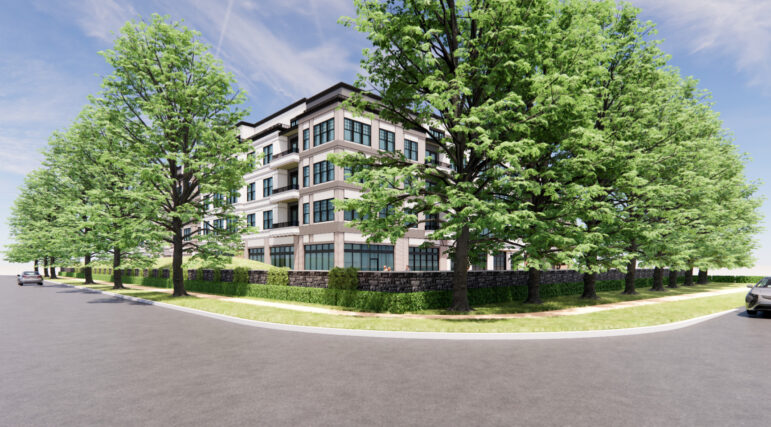
Several elected officials testified that the supersized projects targeted a small number of communities, including Greenwich, where developers prefer to create one-bedroom affordable units, rather than family-sized units, resulting neither in home ownership nor wealth creation.
On the other hand, people including State Rep Roland Lemar (D-96) representing New Haven and Hamden and his wife Yale professor Anika Singh Lemar were having none of it. They called out Greenwich specifically.
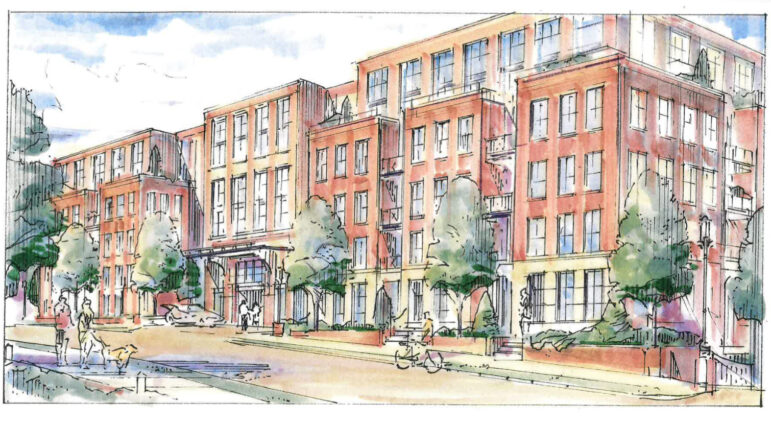
Rep Lemar said 8-30g was not only a good tool, but was perhaps the only tool to incentivize affordable housing creation. He said towns shouldn’t complain about ‘evil profit-driven developers,’ but rather deed restrict naturally occurring affordable housing, better fund their housing authorities and partner with non-profit developers.
Senator State Senator Saud Anwar (D-3) representing East Hartford, East Windsor, Ellington and South Windsor said the “fear and hysteria” of those wishing to take a look at 8-30g were unwarranted and harmful.
State Senator Ryan Fazio (R-36) and Steve Meskers (D-150), both from Greenwich, detailed how problematic 8-30g has been to their town.
“I think we should have a statewide mill rate and Greenwich should pay its fair share, helping the rest of the towns meet their budgetary requirements.”
– Anika Singh Lemar, Clinical Professor at Yale Law School who teaches the Community and Economic Development clinic
Fazio said 8-30g was both “counterproductive and demoralizing” to diverse communities by voiding their local zoning authority.
He said after decades on the books, 8-30g had failed to achieve the desired effect, creating more problems that it solves, given 8-30g voids local control for 138 towns and cities in favor of rules that give special benefit to large developers who create little affordable housing.
Fazio noted only 30 municipalities out of 169 in the state had met the stated goal of achieving 10% affordable housing, and said the law failed to generate upward mobility.
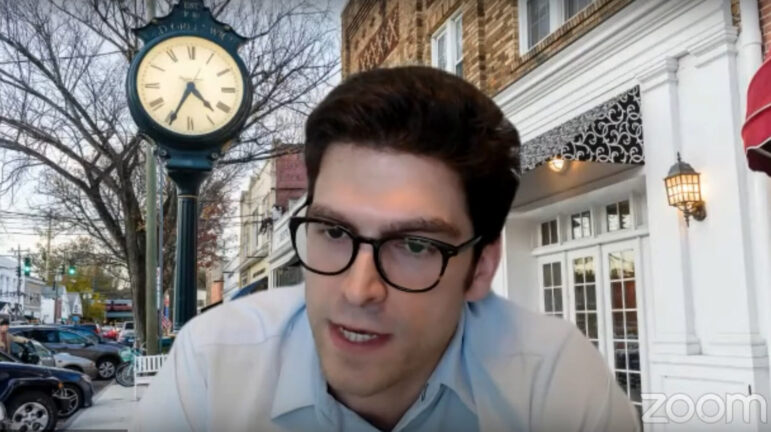
“Since the law went into effect in 1990, the poverty rate in Connecticut has increased more than any state in the country, according to the US Census,” Fazio said.
“Instead we need to encourage and reward diverse forms of affordable housing and local buy-in. 8-30g primarily recognizes government and deed restricted housing, while rewarding dense 8-30g complexes built by big developers.”
Fazio said naturally occurring affordable housing should “count” as affordable, in addition to workforce housing and accessory dwelling units.
“I see no need for a study that will open the door and invite in those who would eviscerate this important tool in the affordable housing kit.”
– Alma Rutgers, Greenwich
State Rep Jennifer Leeper, a Democrat who serves Fairfield and Southport in the 132nd district, said there was no single issue as divisive in her community as 8-30g.
She said the law had a disproportionate impact on a small number of communities.
“(8-30g) results in developers only building in communities where developers want to build, and that have pipes, water and sewer, and has almost no impact on other communities.”
She said 8-30gs developments were adding density to already dense communities.
For example, she said Fairfield has 22,000 housing units.
Rounding that to 20,000 to simplify the calculation, she said to achieve 10% affordable under exclusively 8-30g permits…the town would need to add about 10,000 units, 30% of which would be deeded affordable to reach the 10% goal.
“While it may be mathematically feasible, practically speaking, it’s impossible,” Leeper said.
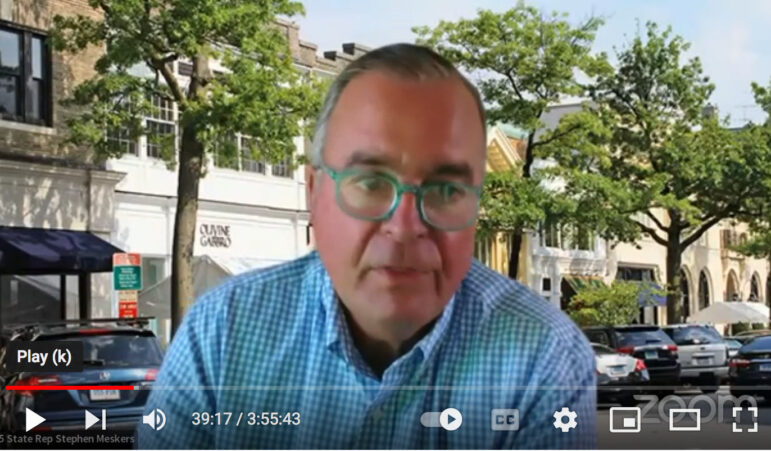
State Rep Meskers (D-150) said while people don’t think of Greenwich as diverse economically, the town has over 30% of it’s population counted as “ALICE” (Asset Limited, Income Constrained, Employed), and 20% of the school population in Title 1 Schools.
Meskers said the problem with 8-30g was the 70-30 ratio of market-rate units to affordable.
Speaking in support of SB -169, he said, “Those affordable units in many cases are single bedrooms, so they’re not really giving you what the goal of diversity in the community should be.”
“We would like to work with the state to find a happy solution to increase our affordable housing stock.”
Meskers said that to achieve a moratorium, a town has to get to a certain number of units with a certificate of occupancy.
“The problem is you have a deficit, and now you have units coming in through the builders, and you get a myriad of units forced through the approval process, with 70% market based and 30% affordable before you can apply to get a moratorium,” Meskers said.
“The shortfall that we have will force us, through developers, to do on the order of 5,000 units of housing, where our shortfall (of affordable units) is on the order of 750 to 1,000 units, depending on how you define the ‘affordable’ stock,” he added.

State Rep Roland Lemar (D-96) serving New Haven and Hamden, said he took a completely different approach.
He said that with skyrocketing rents and home values in the state, housing remained out of reach for many Connecticut residents and 8-30g was the only tool the state had to impact housing creation.
He said there was “misinformation” circulating, saying that housing created before 1990 did not count toward the 10% goal. He clarified that housing created before 1990 did not count when calculating points toward a moratorium (not the 10%).
“It’s a misconception that has been articulated over and over,” he said. “And that’s because towns, upset that they weren’t reaching their goal and being subject to these ‘evil profit-driven developers,’ said, ‘We want some relief,’ so we established a moratorium process. The moratorium points are there to help towns that are showing progress. Of course you don’t show progress by showing units that were developed 35 years ago.”
“No one thinks that 8-30g is supposed to be the one tool that creates housing. Sadly, for communities that don’t take affordable housing construction seriously, that’s the only thing they see,” Lemar said. “They’re not empowering their housing authority. They’re not giving them additional dollars. They’re not being creative with the development that comes in. They’re not going out and deed restricting naturally affordable housing.”
“Claiming that 8-30g ‘developers are pariahs on our town’ is a tool to politically insulate themselves from the fact that they are not taking affordable housing seriously,” Lemar said.
“Towns don’t need to create 10,000 units to reach their goals. …if they’re only looking at 8-30g, and only looking at being sued by a local developer because they’ve denied their application, then maybe yes, but there are numerous other opportunities that communities have to reach moratoriums and better fund their housing authorities, and construct actual units in towns, partner with non-profit developers.”
“They don’t need to create that many units in their towns,” he said referring to the 10%. “That’s only if they want to go through an adversarial process with a local developer.”
“Local control has created economic and racial segregation that we have,” he added. “8-30g has worked.”
As for the argument that naturally occurring affordable housing doesn’t “count” toward the 10%, Lemar said, “If we wanted to include naturally occurring affordable, that number would be more like 50%…We want 100% of our housing stock to be affordable. We established 10% because it meant deed restricted in perpetuity.”
Switching over to public comment, Evonne Klein, a Democrat who is CEO of the CT Commission to End Homelessness, and formerly served as Housing Commissioner under Dannel Malloy, as well as First Selectman in Darien (from 2003-2009) urged a no vote on SB 169.
“8-30g works because we’ve seen affordable housing development in places that may not have otherwise chosen to develop without this added encouragement,” Klein said. “Yet today throughout out state we have homeless individuals and families who have housing vouchers in hand, with no affordable home available to them, including in Fairfield County.”
Ms Klein said Darien has had two moratoriums, the second one having expired in October 2021.
“In Darien, we’re actually building affordable and approving projects without going to court. In the past 15 years we’ve not had an 8-30g application go to court.” She said that under her leadership, the town began the redevelopment and expansion of one of their housing authority properties, “The Heights,” growing it from 52 units to 106 units.
“We also voted and have an inclusionary zoning regulation. We just upped the percentage of affordable units in each project to go from 12% to 14% affordable,” she said. “We took steps to educate the community and made it part of a productive conversation and try to dispel some of the myths.”
“It shouldn’t be a luxury to live in Fairfield County and live near to where you work,” she said.
Sean Ghio from Partnership for Strong Communities said the 8-30g statute was the state’s only tool to grow affordable housing without expending state funding. “It was never intended to be the entire policy for affordable housing. It is one tool. We need more tools.”
Ghio said more than 200,000 households are spending more than 50% of their income on housing costs, and that affordable housing in Connecticut is incredibly concentrated. In Fairfield County, from 2002-2021, there were 5,813 new affordable housing units as counted by the state, and 4,100 of them were in just four cities: Stamford, Bridgeport, Norwalk and Danbury. (see FAQs on the Partnership for Strong Communities website)
Betsy Gara, Executive Director of the Connecticut Council of Small Towns, said, “In certain areas of the state, I have small towns that question why anyone cares about 8-30g. They haven’t heard of it in their town. They haven’t had developers come in and try develop affordable housing because of it.”
Further, she said, there are towns where, based on the available building lots in their community, there’s no way, even if they build on every single available building lot, that they would be able to meet the 10% threshold.
“I do think we need to look at that and see if there is a way to provide a more flexible or realistic housing threshold for the state and maybe it is not a one-size-fits-all housing threshold,” Gara said.
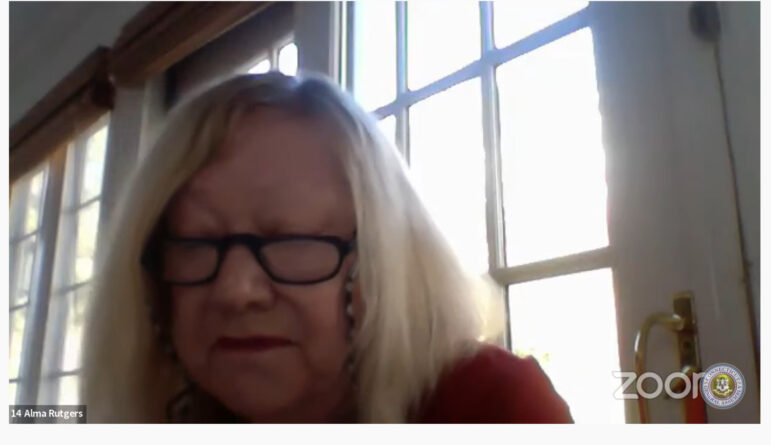
Alma Rutgers from Greenwich said she worried that those who support SB-169 would use it to dismantle 8-30g, which she said was “enormously effective for more than three decades.”
Rutgers said the 10% threshold had been “wildly misinterpreted.”
“Thousands of affordable units have been produced that would not otherwise exist,” Rutgers said. “This legislation was never intended as a state mandate that every Connecticut municipality have 10% of housing units affordable. It was intended to produce affordable housing where zoning did not allow for such housing. The 10% exemption threshold was only to direct the market forces away from municipalities that had already done their fair share.”
Rutgers said amendments allowing for exemptions through moratoria have further incentivized the development of affordable housing.
“I see no need for a study that will open the door and invite in those who would eviscerate this important tool in the affordable housing kit.”
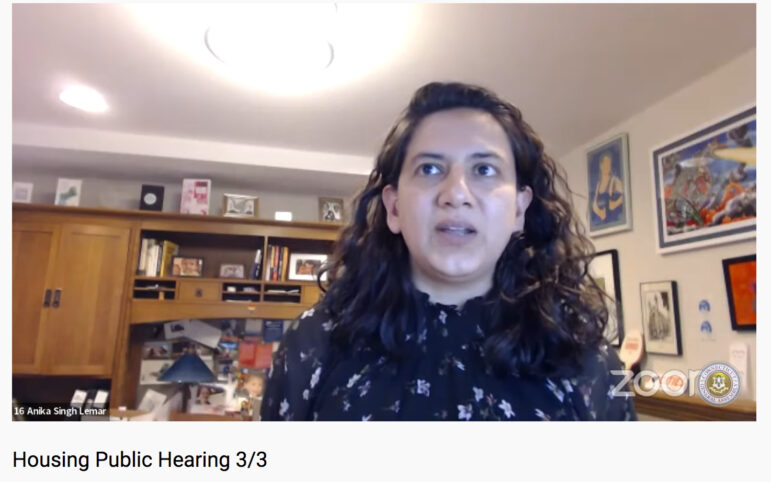
Anika Singh Lemar, the Yale professor, said Connecticut was in a perpetual affordable housing crisis and 8-30g should not be weakened.
“People don’t live in housing plans. People don’t live in the good intentions of hyper-wealthy mansion owners or the planners who carry their bags. People live in housing. 8-30g creates housing.”
“I heard from the Senator from Greenwich that 8-30g is ‘demoralizing’ to our towns,” Singh Lemar said. “I was not aware that our towns have feelings. I will tell you that people do. Do you know what is demoralizing to human beings? Not being able to afford to house your family in safe, secure housing.”
“I heard from the representative from Fairfield that 8-30g permits developers to build in places where people want to live and where there is existing infrastructure. That is a very good reason not to touch 8-30g.”
Ms Singh Lemar continued, “You heard lies about how the 8-30g numbers are calculated. Elderly housing counts. Housing built before 1990 counts.”
Senator Anwar said he agreed with Ms Singh Lemar. He said “fear and hysteria” were unwarranted and harmful.
“Widely disparate mill rates are a big problem,” she said. “But, no, Greenwich’s 11 mill rate didn’t cause its housing affordability crisis. And in higher tax towns, the tax burden gets capitalized into the price. They actually don’t raise the price. The taxes aren’t the cause of the housing crisis.
Rep Zullo asked Ms Singh Lemar to talk more about tax policy and whether it should be a goal for all residents to pay less than 30% of their income on housing costs, including property taxes.
“If taxes continue to go up, isn’t that a real problem?” Zullo asked. “Shouldn’t we be addressing that as well?”
“I’m not disagreeing that we should address it. I think we should have a statewide mill rate and Greenwich should pay its fair share, helping the rest of the towns meet their budgetary requirements, so that East Haven doesn’t have to go up to the 30s,” she said. “Greenwich has a mill rate of 11 and their housing is not cheap.”
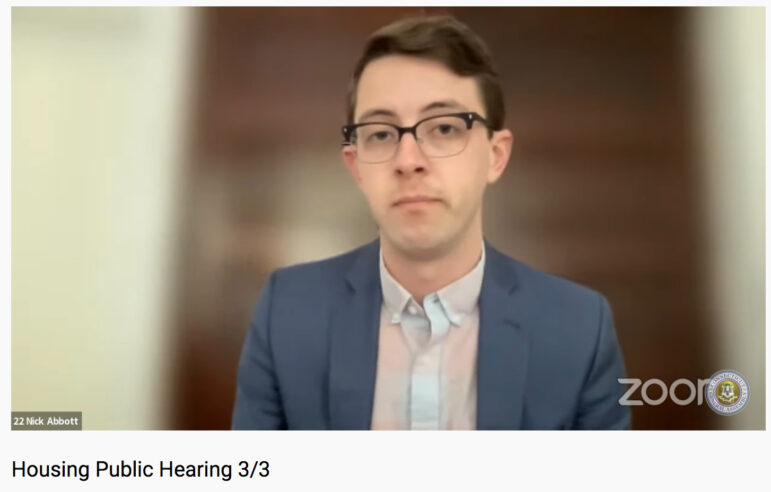
Nick Abbott, who is part of the Desegregate CT team, and a resident of Greenwich, testified in opposition to SB-169.
“Greenwich officials, including some on this call, say, ‘Trust us.’ We don’t need 8-30g to build affordable housing.’ But their record is anything but trustworthy,” he said. “Greenwich bans multi-family housing on 98% of its land.”
“The town has permitted hardly any affordable housing or even multi-family housing at all in the past 30 years, accumulating only 35 housing unit equivalent points over three decades.
“The only way in which 8-30g developments become more common in a particular town is if their housing market is seriously out of wack, meaning that the price of market rate units is so high that they will cross-subsidize the affordable units, which developers lose money on,” he said. “That’s not necessarily a bad thing, but it does show that 8-30g doesn’t present some doomsday scenario.”
“It’s a necessary backstop. One that would be unnecessary if towns like Greenwich did the right thing and actually built multi-family housing and affordable housing,” Abbott said.
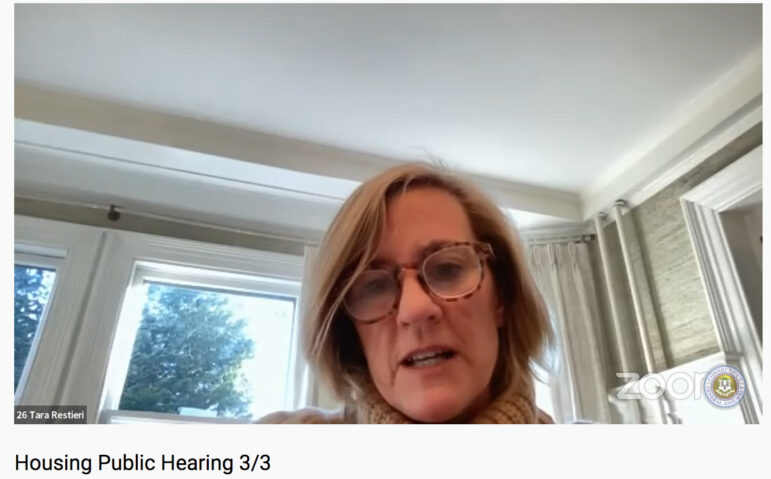
Tara Restieri of Greenwich, who is is a member of both the RTM and the Board of Human
Services objected to SB-169 as written. She submitted a suggested amendment to it.
“I represent as a mebmer of the RTM in district 7 a district which in the past 14 months been inundated with 8-30g projects submitted by developers. There are developers who are taking advantage of the statute.
“In Greenwich there are currently 13 applications submitted for more than 700 new apartments, 1100 new parking spaces, only 210 of which would be affordable,” Restieri said.
“What 8-30g does do when developers are allowed to build, is increase the denominator in the equation and not the numerator,” she said. “I have dozens of neighbors who are collecting funds and creating legal entities to fight these developments collectively. Some of these same neighbors have spent tens of thousands of dollars fighting earlier applications, all who’ve lost.”
“I would ask maybe we solve the problem by completely eliminating the use of 8-30g by private developers and limit its use to housing authorities, such as was proposed by professor Leemer,” Restieri said.

“I think it’s resulted in very unintended consequences. It’s a laudable goal, I think it’s been hijacked by predatory developers and investors who have been able to game the (statute) and use it to supersede local zoning regulations – everything that you and I have to adhere to if we want to build something. And often they change the fabric of our neighborhoods, modest neighborhoods. They take land that could be used for open space preservation of natural resources, wildlife, natural flood mitigation.”
Harrison said she agreed with others who said “the math doesn’t work.”
“It’s virtually a mathematical impossibility for towns to achieve 10% of their housing stock as affordable.
She said SB-169 was a good bill, but the purpose ignores the negative impacts of 8-30g, such as property values, opens pace, historic site preservation, infrastructure capacity, municipal finances, property taxes, public safety and importantly, wildlife and environmental protection.
“In the 30 years since 8-3g passed, climate change is hurting us and the environmental impact of 803g should be studied,” she added.
Harrison said the burden of proof in development applicants is on zoning commissions, which has made it hard to defend decisions modifying or denying massive out-of-scale projects, even when the decisions are based on a town’s own expert testimony, such as a fire marshal or police officials. She said that should be studied.
She said the 10% target was arbitrary and impossible to achieve, and that should be addressed.